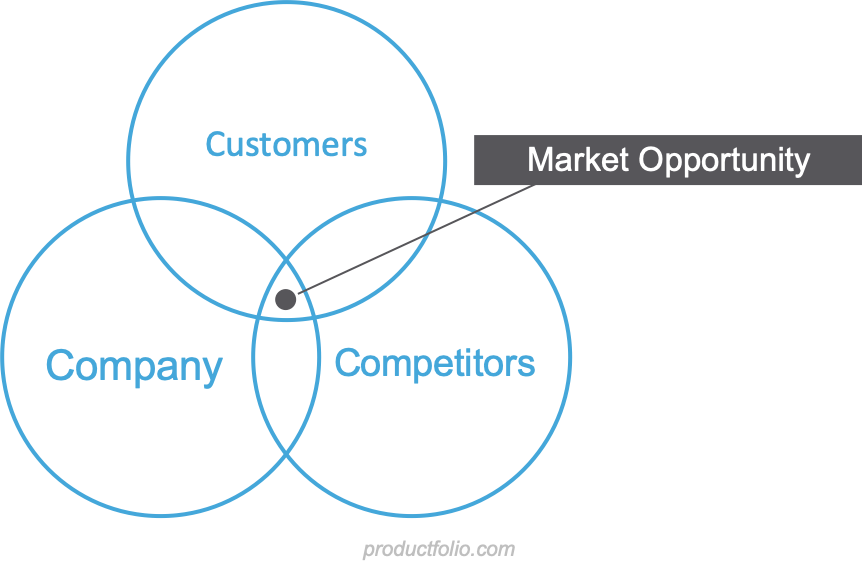Go To Market Strategy
The Go-To-Market Strategy, also sometimes referred to as a Marketing Strategy, describes how we will take a new product or major new feature to market. As the name implies, this is typically a strategy driven by Marketing, but Product is a significant stakeholder in the process and should be actively involved. Consider that Product’s role is ultimately to own Product-Market fit of a solution for our customers, and thus we are extremely vested and informed as to who our customers are and how the benefits of our product are perceived. Marketing are the channel and messaging experts, but we share ownership in the outcome and must work hand in hand.
There are 4 key parts of an effective Go-to-Market (GTM) strategy, each of which is discussed below:
I. Define the Landscape
The 3C’s of Marketing is described three 3 elements to consider for positioning your product – understanding your customers, competitors, and your own company. This is an excellent tool for framing the context in which you’re launching your product. Let’s break it down by each of those pieces:

Customers – Successful products focus on creating value for our target customers. Implicit in that statement, we must understand who our customers are and what they need, to really know what to emphasize with our product. To achieve this, we should understand our customer segments, which of those segments we’ll want to focus on, and in turn what they need. There are terrific frameworks such as Personas, Journey Maps, and Jobs To Be Done (JTBD) that can be used for assessing getting to these answers. Ideally, your company may have already done this analysis. Either way though, we need that understanding of our customers and their needs, as a starting point for out GTM strategy.
Competitors – When positioning your product in the market, we really need to know where the gaps are in the market – what are the unmet needs that our competitors haven’t yet sufficiently addressed? Competitive strategy is a deep topic unto itself but suffices to say we are either competing for contested opportunity or we’re attempting to innovate and disrupt existing competitive territory – the Gartner Magic Quadrant is a useful tool for mapping this out. In either case, we need to know who the key players are, how strong, how innovative they are, and how complete their solution is so that we can identify the openings that we can target with our own product positioning.
Company – consider how your company shapes up. Are you as strong or innovative as your competitors? A SWOT analysis can be useful in assessing your own company, then consider where you fit on that same Magic Quadrant thing above.
II. Goals Definition
To set goals, we first need to understand what’s possible and then set goals, define KPIs for measuring those goals, and targets we hope to achieve.
To do market sizing, TAM/SAM/SOM analysis is useful to really understand the size of the opportunity. This will help to validate your thoughts about the market segments to target as well as inform initial marketing budgets. This framework breaks down the market at 3 levels: Total Available Market (TAM), which asks how many people are conceivably share the problem you’re solving?, Serviceable Available Market (SAM) which asks how many of TAM can be addressed by your solution?, Share of Market (SOM) finally asks what percent of that that market you’re likely to achieve? Putting this all together you can begin to understand a probable outcome that you can target with your plan.
Once we understand the market opportunity, we need to set specific outcomes we hope to achieve and how we’ll measure those outcomes. For example, we might say that we want to increase signups by 60,000 registrations. In that statement, we’ve defined the objective (increased signups), the KPI (registrations), and a target (+60k).
III. Sales Strategy
Now that we’ve defined the landscape, what’s possible and our goals, this is where formulation of the true market plan begins – everything prior to this was really about assessing the market context that that’s the most important part of Product Mgmt to influence and inform.
From here, the messaging needs to be defined in terms of ‘tone of voice’ and emphasis, and we need to determine the channels through which we intend to disseminate our messaging. For example, are we going to use performance marketing channels like paid search that target lower-funnel customers in order to drive near-term registrations? Or, are we looking to build longer-term brand awareness and LTV, which might be better achieved through social marketing and display advertising?
IV. Launch Execution
Finally, this is where the “launch plan” comes into play. With our ecosystem, goals, and channel strategy in place, we need to define the action plan – every major step that needs to occur, by whom, and in what order. This includes the steps leading up to launch such as preparing marketing collateral and deploying code, to tracking the identified KPIs and ensuring retrospective review of out GTM is happening. This part of launch is typically handled by a Project Manager or perhaps a coordinator within the Marketing or Product Marketing groups.
Summary
There we have it – Go To Market (GTM) strategy, in a nutshell, is comprised of market landscape, goals definition, channel strategy, and the launch/execution plan. GTM, in general, is driven by Marketing but Product Mgmt must be a significant contributor in the process, particularly in shaping those first couple pieces.


